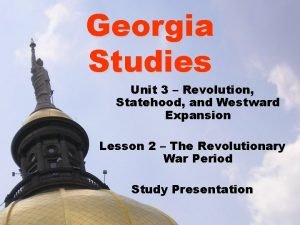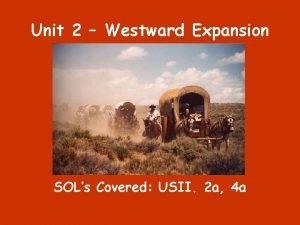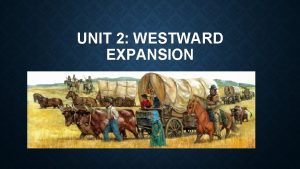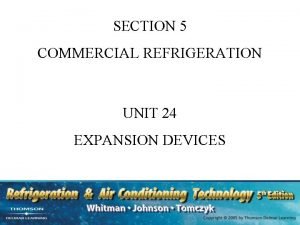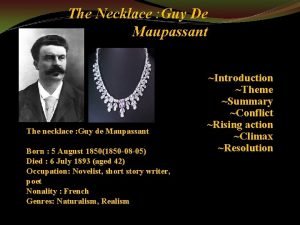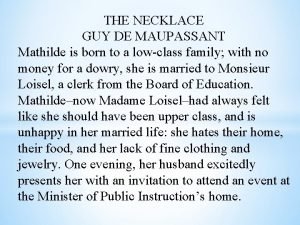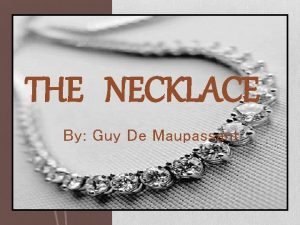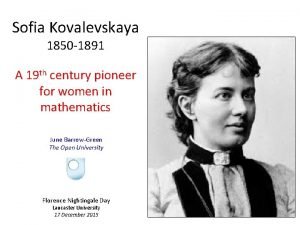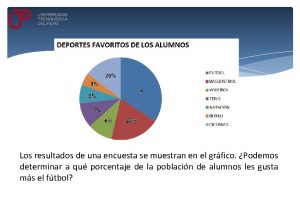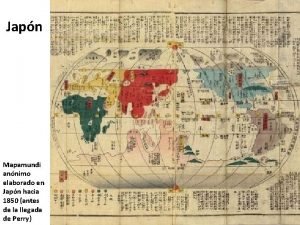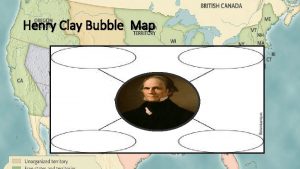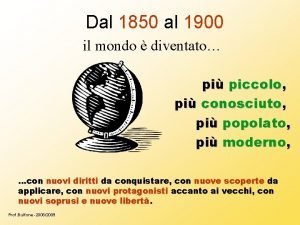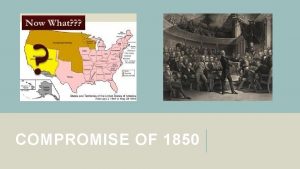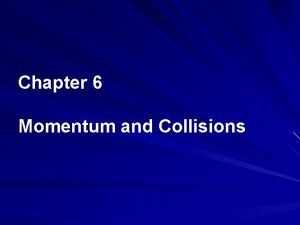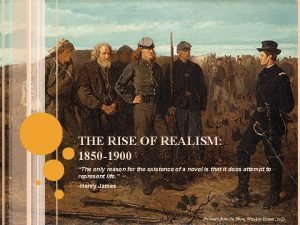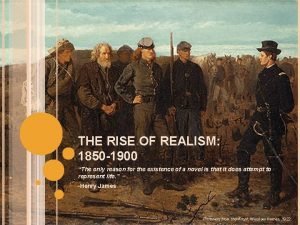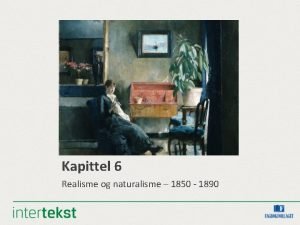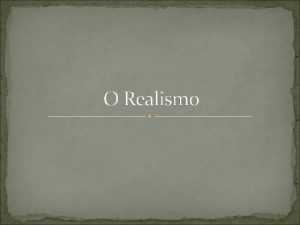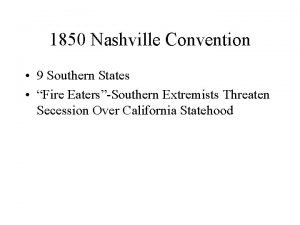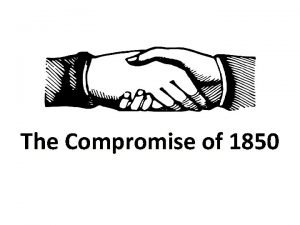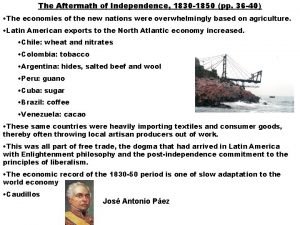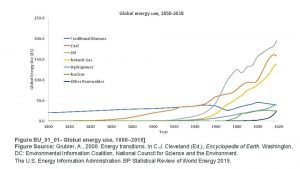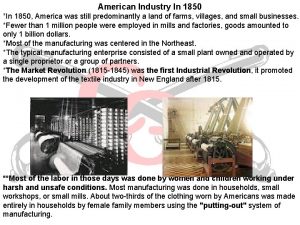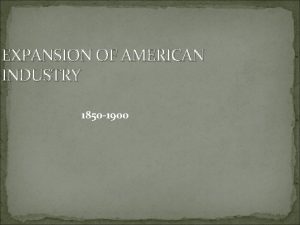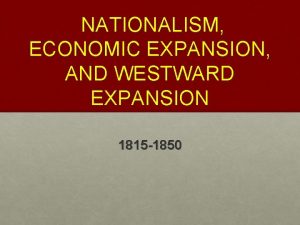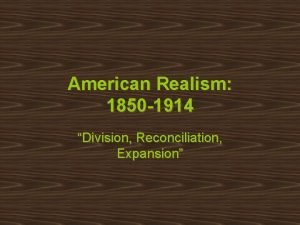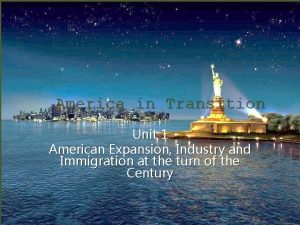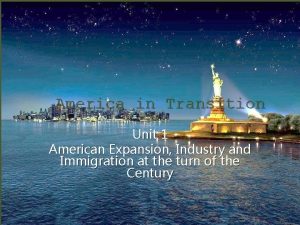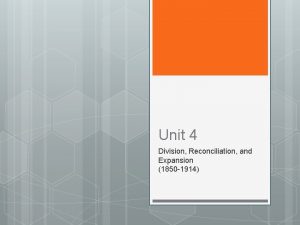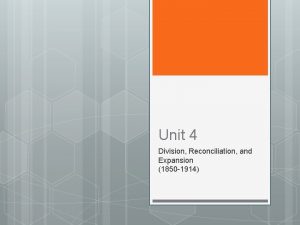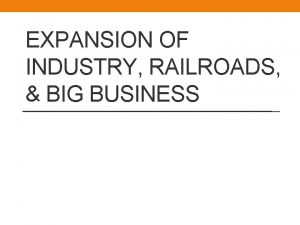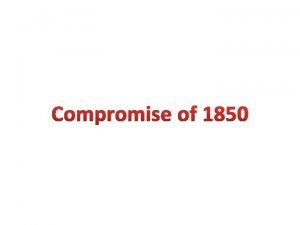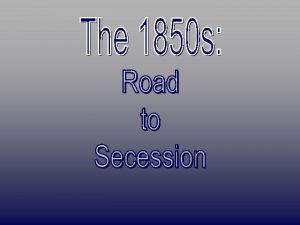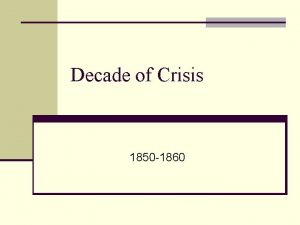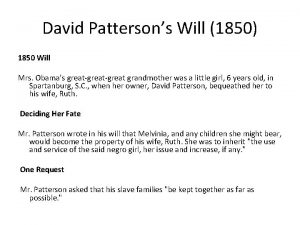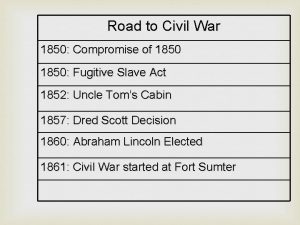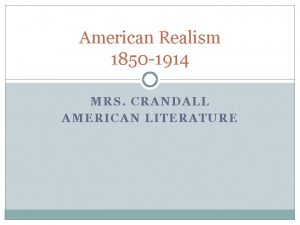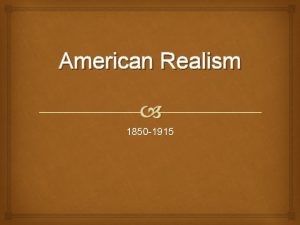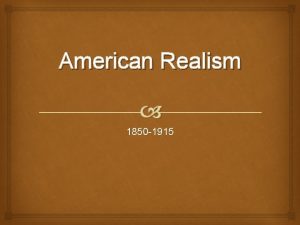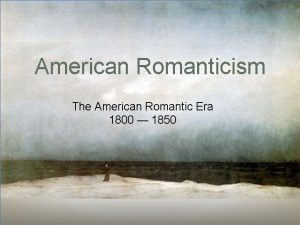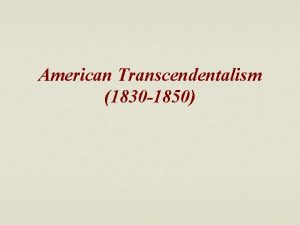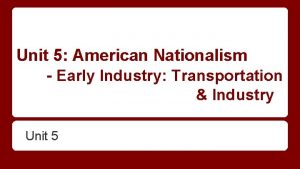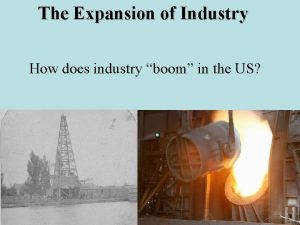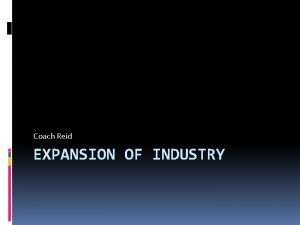Unit 5 The Expansion of American Industry 1850




























































- Slides: 60

Unit 5 The Expansion of American Industry (1850 -1900)

n SSUSH 11. a Explain the impact of the railroads on other industries such as steel and on the organization of big business. n SSUSH 11. b Describe the impact of the railroads in the development of the West, including the transcontinental railroad, and the use of Chinese labor.

n SSUSH 11. c Identify John D. Rockefeller and the Standard Oil Company and the rise of trusts and monopolies. n SSUSH 11. d Describe the inventions of Thomas Edison, including the electric light bulb, motion pictures, & the phonograph, & their impact on American life

A Technological Revolution - FYI n Indoor electric lighting did not exist in 1865. Instead, the rising and setting of the sun dictated the rhythm of a day’s work. n After dark, people lit candles or oil lamps if they could afford them. If they could not they simply went to sleep, to rise at the first light of dawn.

A Technological Revolution - FYI n Imagine summers without the benefits of refrigeration! n Ice was available in 1865, but only at great cost. n People sawed blocks of ice out of frozen ponds during the winter, packed them in sawdust, and stored them in icehouses for later use.

A Technological Revolution - FYI n Communication was also very slow in those days. n Most mail from the East Coast took ten days to reach the Midwest and three weeks to get to the West. n Think of email and texts today… n An immigrant living on the frontier would wait months for news from relatives in Europe.

A Technological Revolution - FYI n By 1900, daily life had changed dramatically in the United States. n Between 1790 and 1860, the Patent and Trademark Office of the Federal Gov’t issued just 36, 000 patents (licenses to make, use, or sell an invention). n In contrast, b/w 1860 and 1890, 500, 000 patents were issued for inventions.

Inventions! 1. 2. 3. 4. 5. 6. Telegraph – Samuel Morse Telephone – Alexander G. Bell Phonograph – Thomas Edison Filament Light bulb – Thomas Edison Motion Pictures – Thomas Edison Central Power Station – Thomas Edison (direct current) Transformer (alternating) – George Westinghouse 8. Bessemer Process – H. Bessemer 7. 1. Brooklyn Bridge & William Kelly

A technological revolution: Electric Power 11. d n Thomas A. Edison (“There is always a better way to do something, find it!” He patented over 1, 000 inventions! n Helped to make electricity widely available. n Improved stock ticker n Phonograph, electric light bulb, motion pictures n 1882, Central power station n Westinghouse n 1885 George Westinghouse and alternating current. n Use of transformer made use of electricity in homes practical. n General Electric and Westinghouse Electric.

The Railroad gets connected! 11. A n In 1850, steam powered ships still provided much of the nation’s transportation. n Before the Civil War, most of the railroad tracks were in short lines that connected neighboring cities, mainly in the East. n There was no standard track width, or gauge, so each train could only travel on certain tracks. n As a result, goods and passengers often had to be moved to different trains, which caused costly delays. n To make matters worse, they were dangerous b/c trains could not communicate and brakes were unreliable…. eeekkkk

The Transcontinental RR (11. B) n In 1862, a huge project began in Sacramento, CA by the Central Pacific RR company and in Omaha, NB by the Union Pacific RR company to connect one line. n On May 10, 1869, the project was complete with the final “Gold” spike being driven in by Leland Stanford at Promontory Point, Utah. n Most of the workers on the railroad were immigrants. Irish for the Union Pacific and Asian, especially Chinese, for the Central Pacific. n This railroad officially connected the east to the west.



A Native American watching the newly completed transcontinental railroad in Nevada (1868).

Problems with the RR - FYI n Rails were not standardized, this caused a lack of mobility. n Trains were often noisy, dirty, and uncomfortable. n People feared for their safety and distrusted most trains. n And scheduling for the train to be “On Time” was a nightmare, b/c of the time differences from town to town. Each town set its time according to solar time.

Solutions for the RR 11. A n Steel rails replaced iron rails (Bessemer Proc. ) and signals and track gauges became standardized. n George Westinghouse developed more effective air brakes and Granville Woods patented a telegraph system for communicating with moving trains, thus reducing the risk of collisions. n In 1883, the railroads adopted a national system of time zones to improve scheduling. As a result, clocks in broad regions of the country showed the same time. n Four time zones were used: Eastern, Central, Mountain, and Pacific (we still use these today)

Changes brought forth by the RR (draw please) Gov’t reg. of private industry Grow of towns and cities Rapid Growth of Railroads Creation of nationwide market Consolidation of RR Greed and Corruption

The Growth of Big Business: 11. A n The period of invention after the Civil War set the stage for the great industrial growth. n Still, it would take more than technology to change the U. S. , it would take entrepreneurial people to make the difference. n These individuals became known as “Robber Barons” or “Captains of Industry”.

Robber Barons (Captains of Industry) 11. A & C Andrew Carnegie: Steel n Robber Baron implies that these individuals build their fortunes by stealing from the public, and in turn drained the natural resources. n Captains of Industry paints John D. Rockefeller: Cornelius Vanderbilt: Railroads Oil a more positive image of hard work and success in the building of the business world as we know it.

Big Business: draw in your notes

Big Business Problems n n n 11. A & C Monopoly: complete control of a product or service. Cartel: a loose association of business that make the same product. Trust: managing companies as a single unit. Ex. Standard Oil (John D. Rockefeller) Sherman Antitrust Act: law that prevents any combination of companies that restrain interstate trade or commerce. Social Darwinism: Those who were more “fit” would “survive” in the business world. (Carnegie really believed in this idea) n Methods of Industrial Control n n Horizontal consolidation (same type of business bought by one company, ex. Rockefeller w/oil) Vertical consolidation(different type of business bought by one company, ex. Carnegie w/steel; ex: t-shirts)

Okay, that’s pretty much all of 11. A-D Now on to SSUSH 12: The student will analyze important consequences of American industrial growth.

n SSUSH 12. a n SSUSH 12. b n Describe Ellis Island, n Identify the change in immigrants origins to southern and eastern Europe, and the impact of this change on urban American Federation of Labor, Samuel Gompers.

Growth of the West & Labor Strikes n SSUSH 12. c n SSUSH 12. d n Describe the growth n Describe the 1894 of the western population and its impact on Native Americans with reference to Sitting Bull and Wounded Knee. Pullman strike as an example of industrial unrest.

“Industrialization and Workers” n The Growing Work Force (12. a and b) n Immigration: n n 1860 – 1900 14 million immigrants to U. S. Contract Labor Act: 1864 law allowed employers to enter into contracts with immigrants. Similar to Indentured Servants. 8 – 9 million migrants entered the cities.

Immigration: n Religious Persecution, Economic strife, and the promise of a better life in America brought millions of European immigrants to the country in the late 1800’s. n B/t 1865 -1920, over 30 million people came to USA. n The population doubled!!!

The Journey (12. a) n With new steamships, journey was one week. n Most stayed in STEERAGE. n n n Large open area beneath ship’s deck. Limited toilets, no privacy, poor food. Cheap fare. n From Europe? n Came to Ellis Island on East Coast, “The Golden Door. ” (NY) n From Asia? n Came to Angel Island on West Coast. n Most used to be from Germ, GB (old; Western Europe). n Now, they were from Southern and Eastern Europe (Russia, Italy, Greece – new wave)

Immigrants from Europe (12. a) n 1892, US Gov’t opened Ellis Island, with Statue of Liberty, to immigrants. n Seen as a symbol of the US as a place of refuge and hope. n All immigrants had to have a physical. n If they had a contagious disease, went into quarantine. n Could be deported, like those with trachoma (eyes). n Criminals waited on ports to trick immigrants out of money with fake jobs/lodging. n Went and settled in areas where previous settlers of their homeland were (ghettos). n Mostly in port of entry, only 2% went south. n Found jobs with less than average wages.


The Statue of Liberty “Give me your tired, your poor, your huddled masses yearning to breathe free, the wretched refuse your teaming shore. Send these, the homeless tempest tossed to me. I lift my lamp beside the golden shore. ”

n "He doesn't like my name. . . Of course we couldn't all come over on the Mayflower. . . But I got here as soon as I could, and I never wanted to go back, because to me it is a great privilege to be an American citizen. " - Anton Cermak, Czech-born Chicago mayoral candidate, 1931 n "Observe immigrants not as they come travel-wan up the gang-plank, nor as they issue toil-begrimed from the pit's mouth or mill-gate, but in their gatherings, washed, combed, and in their Sunday best. . [They] are hirsute, low-browed, big-faced persons of obviously low mentality. . . They simply look out of place in black clothes and stiff collar, since clearly they belong in skins, in wattled huts at the close of the Great Ice Age. These ox-like men are descendants of those who always stayed behind. " - Sociologist E. A. Ross, 1914

n "These men of many nations must be taught American ways, the English language, and the right way to live. " - Henry Ford, on immigrants n "Remember, remember always that all of us, and you and I especially, are descended from immigrants and revolutionists. " n Franklin D. Roosevelt

Immigration n On the West Coast, Asian immigrants found America less tolerant than the east coast. Cultural differences made Asians the target of suspicion and hostility. n Held at Angel Island for longer n Discrimination caused Chinese immigrants to settle together (Chinatown, etc…). n Labor Unions excluded the Chinese, as they drove wages down, and eventually, even the government discriminated, passing the Chinese Exclusion Act in 1882.

Example of Anti-Asian Sentiment


Check this out: http: //www. nytimes. com/interactive/2009/03/10/ us/20090310 -immigration-explorer. html

The Growing Cities Not only were immigrants moving to the cities, Americans were migrating to the cities to escape the economic problems facing farmers.

Growing Cities n The percentage of n Racial America’s population living on farms fell from 72% to 54%. n Technological advances reduced the need for farm labor. discrimination drove many African Americans out of the South. n The influx of people forced new construction, especially subways and skyscrapers.

Increasing Efficiency (FYI, background knowledge) n In 1881, Frederick Winslow Taylor set out to improve worker efficiency in the steel plant where he was chief engineer. n He began to study the workers, trying to see how much time it took to do various jobs. n Then he broke down each task into a # of steps and determined how long each step should take. n He wanted more productivity from less time. n The workers hated Taylor’s ideas, they feared that increased efficiency would result in layoffs or a lower rate of pay for each piece of work.

Section #4 “The Great Strikes” ®Rich (12. d) vs. Poor ® 1890 9% of pop. held 75% of nations wealth. ®Socialism: economic and political philosophy that favors public (social) control of property and income. ®Cooperate, ®Karl ®Labor not compete. Marx = “Communist Manifesto” Unions ®Trade Unions ®The Federal Society of Journeymen Cordwainers (shoemakers) ® 1806, Outlawed for engaging in strikes. ®National Trades Union

Section #4 cont. ® 12. b The American Federation of Labor (AFL) Samuel Gompers ® Only skilled workers. ® Three main issues for unions: ® l Higher Wages l Shorter Working Hours l Safer Working Conditions Collective Bargaining: group bargains with employer for changes ® Samuel Gompers

Employers forbade union meetings and fired union organizers. “Yellow Dog” contracts – workers promised not to join or strike Refused collective bargaining if strikes occurred. Refused to recognize unions as the workers’ legitimate representatives.

Four Major Strikes 1877 -1894 1. 2. 3. 4. Railroad Strike – 1877 Haymarket Strike – 1886 Homestead Strike – 1892 Pullman Strike - 1894

Pullman Strike – 1894 *** 12. d n This strike involving the RR marked a shift in the Federal Government’s involvement with labor-employer relations. n Sleeping-car maker, George Pullman considered himself a caring industrialist. n He donated money to build schools, banks, and utilities in his hometown of Chicago. n But, when the economy took a nose dive in 1893, he had to lay off workers and cut wages. n A small group tried to protest to him and he fired them on the spot, causing the local union to go on strike.

Pullman Strike - 1894 n Pullman refused to bargain and shut down the plant. n The American Railway Union, lead by popular labor organizer Eugene V. Debs, called for a boycott of Pullman cars throughout the country. n By June of ’ 94 over 120, 000 RR workers joined in the strike. n The strike got out of hand (people couldn’t take trains for transport, shipment of goods was slowed, as was mail) & the fed. Gov. was brought in to help. n The strike broke the Sherman Antitrust Act n On July 4, 1894 President Grover Cleveland(1885 -89 & 1893 - 97) sent in 2, 500 federal troops to enforce the law.

Pullman Strike - 1894 n The Pullman strike and its outcome set an important pattern. n In the years ahead, factory owners appealed frequently for court orders vs. unions. n The Fed. Gov. regularly approved these appeals and helped to limit the growth of unions for the next 30 years.

Moving West (FYI) n Why did they want to go west? n 1. ) Explore! n n 2. ) New Beginnings! n n In life, opportunity, etc. 3. ) Be own Boss! n n The Great Plains, the Pacific Northwest, & the Southwest. Can own their own farm. 4. ) Overpopulated! n East is way too crowded.

Moving West: FYI n Big Business owned land. n RR companies profited as settlers moved. n Land next to RR especially popular. n Morrill Land Grant Act n Created to support state colleges. n Fed Gov’t gave land to state gov’t, they sold it to fund agricultural land-grant colleges. n Homestead Act (signed by Pres. Lincoln) n Fed Gov’t gave land directly to settlers!

It’s a “hard knock life” for settlers: FYI n Water was scarce, used buckets to collect rain. n This carried “Prairie fever” or typhoid. n Working prairie sod was back-breaking labor. n Women made soap, clothing, candles, and preserved food. n Families cooperated in raising houses/barns, sewing quilts, husking corn, etc.

Conflict with Native Americans (12. c) n Remember… n Clearing the East of Indians; President Jackson; Trail of Tears; Reservations; Assimilation; War. n Clashes of Culture! n n Indians and settlers looked at the world differently. Settlers felt that the resources were there to be used. n n Settlers used large scale hunting, mining, and farming. Plains Indians used only the resources they needed for their actual needs. n They saw the white settlers as being greedy and destructive.

Fighting begins, with the Sioux n Little Bighorn n The Black Hills of South Dakota had been set aside for the Sioux and Northern Cheyenne n 1874 - U. S. Army exploring party found gold n n n Settlers went looking Gov. tried to buy the Black Hills for gold (Sioux considered land sacred) 1875 and 1876 - Sioux warrior left their reservations and united under the leadership of Sioux chief, Sitting Bull

Massacre at Wounded Knee n After Sitting Bull died, some American soldiers tried to arrest some Indians who left their reservation. n Shots were fired and more than 200 unarmed Sioux (women & children) were killed.

A way for you to remember… n Sitting Bull is sitting…

Indians way of life destroyed: FYI n Whites killed buffalo n Indians depended on buffalo to survive (how? ) n As conditions grew worse and Indians were forced onto reservations, many whites wanted to help & an Indian Rights Movement began. n Helen Jackson wrote, A Century of Dishonor and said, “It makes little difference…where one opens the record of the history of the Indians; every page and every year has its dark stain. ” n Some felt Indians should be more “civilized” n What does this mean? How can this happen?

n Many white though that only solution was to make the Indians become more like the whites - Assimilation - to adopt the culture of the people around you n Dawes Act (1887) n Intended to make Indians give up their traditions and accept White customs n Reservation lands were divided up in farm plots for families and individuals (40 to 160 acres) n Any remaining land was sold to white settlers n Profits used to pay for Indian schools n Indians who accepted the plots of land could become citizens for the 1 st time Assimilation: FYI n Dawes Act failed n Many western Indians didn't want to settle down as farmers n Lacked tools and training n Many sold their plots to white settlers cheap n End 1800's - situation of the American Indians was tragic n 20 th century U. S. government finally realizes importance of Indian way of life

What happened with Indian Territory? FYI n 70 Indian Nations forced onto Reservations. n After the Civil War, many settlers began to enter their government-given land. n Due to large amount of settlers Gov’t opened up 2 million acres of Indian Territory, that hadn’t been assigned yet, to the settlers. n These settlers, “Boomers”, staked off hundreds of claims within a few hours. § Oklahoma City had 10, 000 resident at the end of the 1 st day. n Some settlers, “Sooners”, had already sneaked past the gov’t to stake a claim.

Cause and Effect: Westward Expansion n Causes: n n n Big Business put Western land up for sale. Morrill Land Grant Act provides state gov’ts with millions or acres to sell. Homestead Act gives land to settlers willing to farm. European immigrants, people seeking opportunity, and people fleeing racial prejudice in the East seek land in the West. California Gold Rush draws thousands of fortune seekers. n Effects: n n n Violence erupts between settlers and Native Americans. Many Native American groups are destroyed or displaced. Challenges of prairie farming lead to increased mechanization. Bonanza farms and cattle ranching industries develop. Frontier myths influence national identify.

Just to make sure you’re aware… n 1. GW n 2. JA n 3. TJ n 4. JM n n n n 5. JM 6. JQA 7. AJ 8. MVB 9. WHH 10. JT 11. JP 12. ZT n 13. MF n 14. FP n 15. JB n 16. AL n 17. AJ n 18. USG n 19. RBH n 20. JG n 21. CA n 22. GC n 23. BH n 24. GC * 25. WM

The Presidents: Write it all =) n 20. ) James Garfield n Assassinated n https: //www. youtube. com/watch? v=w. VYEMf_6 EHo n 21. ) Chester Arthur n Est. civil service exams n https: //www. youtube. com/watch? v=UXd 7 xf 5 h_V 0 n 22. ) Grover Cleveland n n Indiscretions…. Tried to lower tariffs n https: //www. youtube. com/watch? v=RNIXmr. ZAJ 4 Q n 23. ) Benjamin Harrison n Created huge debt; highest tariffs n https: //www. youtube. com/watch? v=73 jt. V 1 KMLM 4 n 24. ) Grover Cleveland n Used troops in Pullman strike

The Gilded Age n Coined by Mark Twain. n Gilded – “covered in a thin layer of gold”. n Means a thin but glittering layer of prosperity covered the poverty and corruption of much of society. n Golden time for industrialists. n So much that it covered: n n The immigrants poverty Abuse of power in business and gov’t. n So… what’s Gilded? ? ?
 American expansion westward/manifest destiny
American expansion westward/manifest destiny Unit 3 rev. statehood and westward expansion
Unit 3 rev. statehood and westward expansion Homeland security
Homeland security Unit 2 westward expansion vocabulary
Unit 2 westward expansion vocabulary Thermostatic expansion valves respond to changes in
Thermostatic expansion valves respond to changes in Where was prussia in 1850
Where was prussia in 1850 The necklace theme
The necklace theme Matilda was born in a family of
Matilda was born in a family of Climax in the necklace
Climax in the necklace Sofya kovalevskaya (1850 – 1891)
Sofya kovalevskaya (1850 – 1891) Nmercado livre
Nmercado livre Neoclassical 1750 to 1850
Neoclassical 1750 to 1850 Se muestran resultados
Se muestran resultados Japon mapamundi
Japon mapamundi Explain the compromise of 1850
Explain the compromise of 1850 Scoperte scientifiche dal 1850 al 1900
Scoperte scientifiche dal 1850 al 1900 Who created the compromise of 1850? *
Who created the compromise of 1850? * A 1850 kg luxury sedan stopped
A 1850 kg luxury sedan stopped Realism 1850 to 1900
Realism 1850 to 1900 Realism 1850 to 1900
Realism 1850 to 1900 Realismen i norge
Realismen i norge Entre 1850 e 1900 surge nas artes europeias
Entre 1850 e 1900 surge nas artes europeias Nashville convention 1850
Nashville convention 1850 Compromise of 1850
Compromise of 1850 1850*36
1850*36 Compromise of 1850
Compromise of 1850 Marat artist
Marat artist Compromise of 1850
Compromise of 1850 Billions8
Billions8 Unit 6 review questions
Unit 6 review questions Hình ảnh bộ gõ cơ thể búng tay
Hình ảnh bộ gõ cơ thể búng tay Ng-html
Ng-html Bổ thể
Bổ thể Tỉ lệ cơ thể trẻ em
Tỉ lệ cơ thể trẻ em Chó sói
Chó sói Tư thế worm breton là gì
Tư thế worm breton là gì Hát lên người ơi
Hát lên người ơi Kể tên các môn thể thao
Kể tên các môn thể thao Thế nào là hệ số cao nhất
Thế nào là hệ số cao nhất Các châu lục và đại dương trên thế giới
Các châu lục và đại dương trên thế giới Cong thức tính động năng
Cong thức tính động năng Trời xanh đây là của chúng ta thể thơ
Trời xanh đây là của chúng ta thể thơ Cách giải mật thư tọa độ
Cách giải mật thư tọa độ 101012 bằng
101012 bằng độ dài liên kết
độ dài liên kết Các châu lục và đại dương trên thế giới
Các châu lục và đại dương trên thế giới Thơ thất ngôn tứ tuyệt đường luật
Thơ thất ngôn tứ tuyệt đường luật Quá trình desamine hóa có thể tạo ra
Quá trình desamine hóa có thể tạo ra Một số thể thơ truyền thống
Một số thể thơ truyền thống Cái miệng nó xinh thế chỉ nói điều hay thôi
Cái miệng nó xinh thế chỉ nói điều hay thôi Vẽ hình chiếu vuông góc của vật thể sau
Vẽ hình chiếu vuông góc của vật thể sau Thế nào là sự mỏi cơ
Thế nào là sự mỏi cơ đặc điểm cơ thể của người tối cổ
đặc điểm cơ thể của người tối cổ Thứ tự các dấu thăng giáng ở hóa biểu
Thứ tự các dấu thăng giáng ở hóa biểu Vẽ hình chiếu đứng bằng cạnh của vật thể
Vẽ hình chiếu đứng bằng cạnh của vật thể Phối cảnh
Phối cảnh Thẻ vin
Thẻ vin đại từ thay thế
đại từ thay thế điện thế nghỉ
điện thế nghỉ Tư thế ngồi viết
Tư thế ngồi viết Diễn thế sinh thái là
Diễn thế sinh thái là

